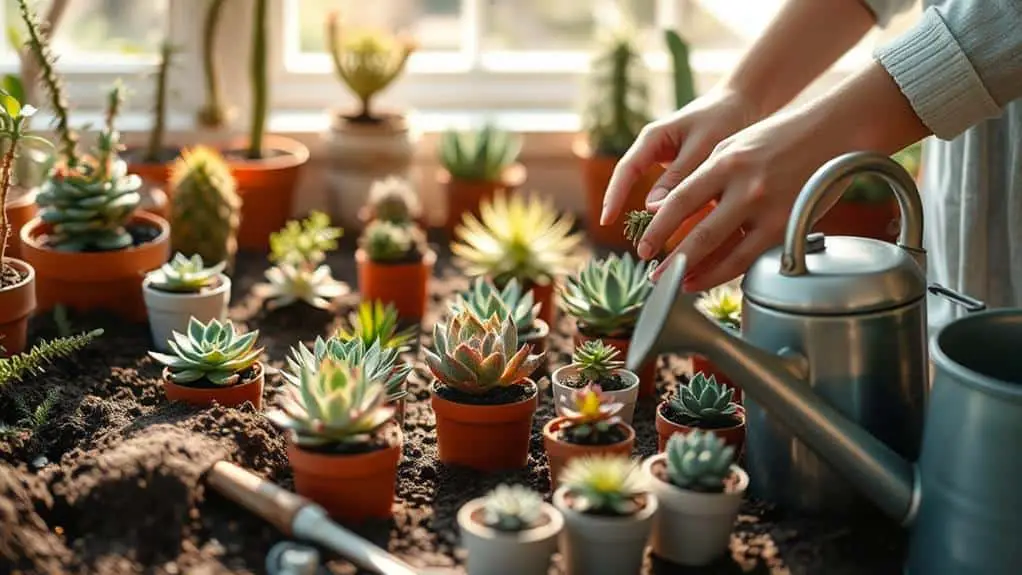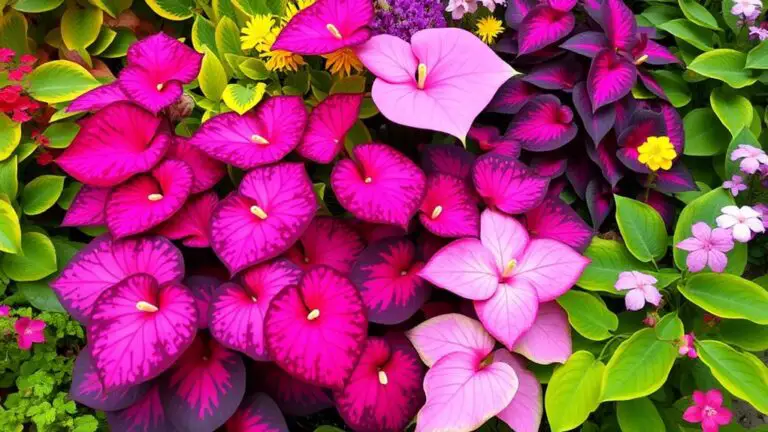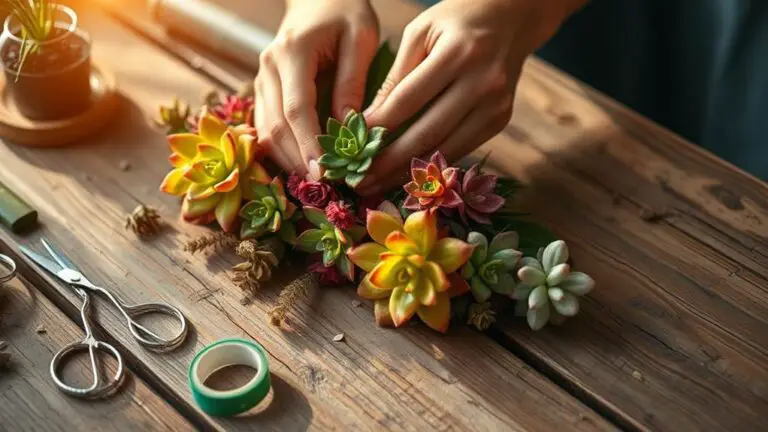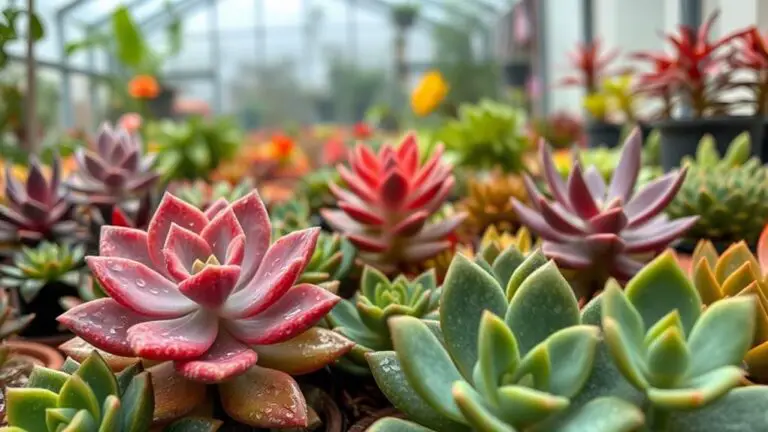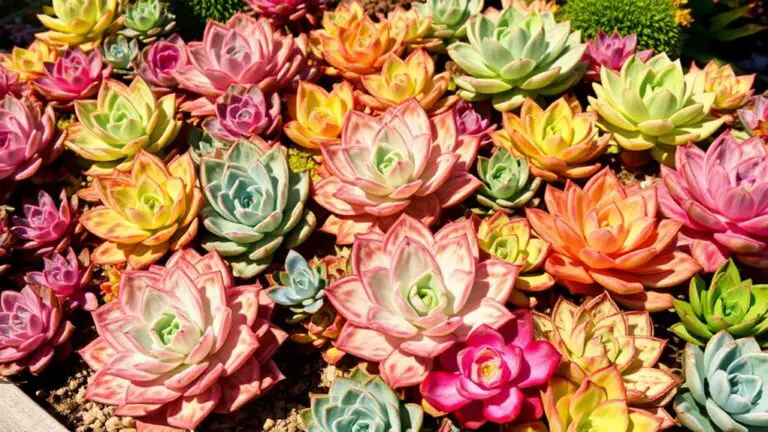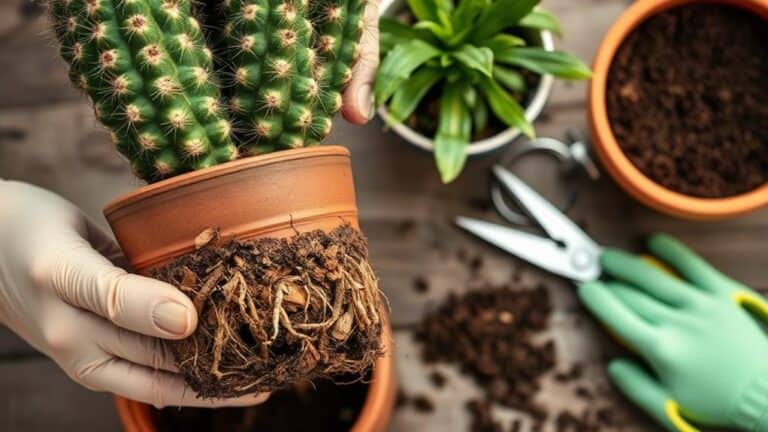Planting Succulents in 7 Simple Steps for Beginners
Starting your succulent garden might seem intimidating, but it's simpler than you think. First, gather the right materials: well-draining soil, pots with drainage holes, and a few basic tools. Next, think about your climate and sunlight exposure to choose the best succulent varieties. With these essentials in place, you're ready to prepare your soil, arrange your plants, and make sure they're spaced correctly. But what's the key to keeping them thriving once they're planted? Let's walk through the remaining steps to help your succulents flourish with minimal effort.
Gather Your Materials

When you're ready to start planting succulents, the first step is to gather all the necessary materials.
You'll need well-draining soil, which is essential for succulents. Look for a mix that includes about 60% nonorganic materials like sand or pumice. This helps with ideal drainage and prevents root rot.
Next, gather your tools. A trowel is handy for digging, while gloves protect your hands. A moisture meter or even a chopstick can help you check soil moisture levels before watering. This way, you won't overwater your succulents.
Choose containers that have drainage holes. Terracotta pots are a great option because they allow for proper airflow and help prevent root rot. Make certain your containers are the right size for your succulents.
Before planting, it's important to select succulents that are suitable for your plant hardiness zone. This guarantees they'll thrive in your local climate.
Understand Your Climate

Before planting succulents, it's essential to understand your local climate.
Check your area's temperature range to see which varieties can handle the heat or cold, and note the amount of daily sunlight.
Most succulents need at least 4-6 hours of direct sunlight, so make sure your garden has the right conditions for them to thrive.
Assess Temperature Range
Understanding your climate is vital for successful succulent planting. Succulents thrive best in a temperature range of 60 to 80°F, so knowing your local climate will help you make the right choices. Some varieties, like Sempervivum, can handle extreme temperatures as low as -30°F. On the other hand, many succulents prefer warmer conditions above 50°F.
Before you start planting, be sure to protect your succulents from extreme temperatures. Only a few types can survive below-freezing conditions. For those of you in colder climates, Sedums and Sempervivums are excellent choices due to their frost-hardiness. These hardy succulents can tolerate a range from 40°F to -20°F and still keep thriving.
Monitoring local weather patterns can also guide you on the best times for planting. By keeping an eye on the weather, you can guarantee your succulents aren't exposed to sudden temperature drops or heatwaves. This step is essential for their survival and growth.
Take the time to understand your local climate, and you'll be well on your way to a successful succulent garden. Happy planting!
Evaluate Sunlight Exposure
After evaluating your local climate and temperature ranges, it's time to focus on another critical factor for succulent success: sunlight exposure. Succulents need at least 4-6 hours of sunlight daily. Many varieties thrive with 2-3 hours of direct morning sunlight. This helps them grow strong and healthy.
Assess your garden's microclimates to find areas with different light levels. Some spots may offer partial sun, while others get full sun. This will assist you in deciding which succulents to plant where.
Watch your succulents for signs of light stress. Too much sun can cause sunburn, leaving white or brown patches on leaves. If they're in too much shade, they might stretch toward the light.
For indoor succulents, place them near south-facing windows. These windows usually get the most sunlight. If that's not an option, consider using grow lights to guarantee they get adequate light.
Choose the Perfect Spot
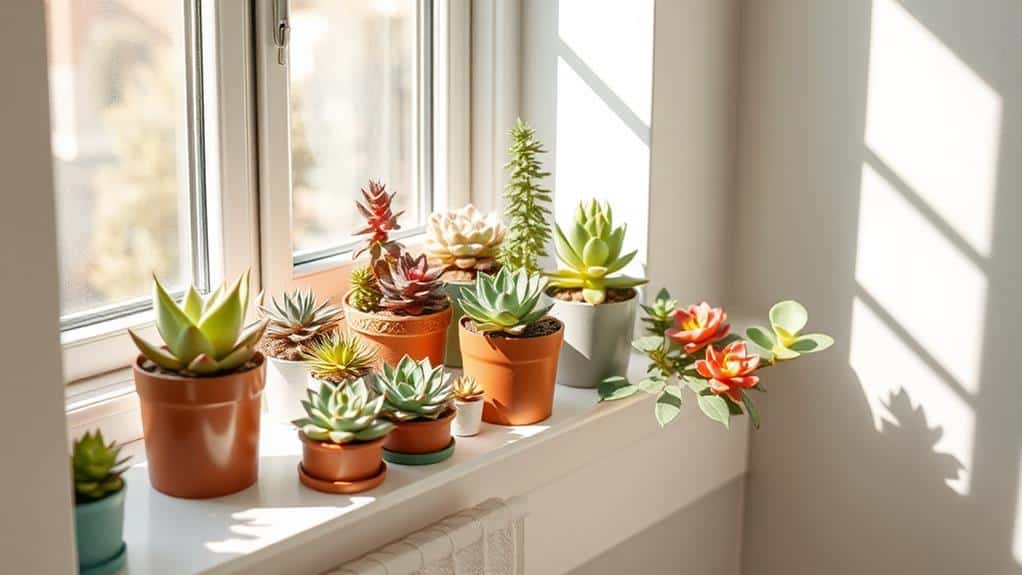
Choosing the perfect spot for your succulents is essential to their success. First, assess the sunlight exposure in your chosen area. Most succulents need at least 4-6 hours of sunlight daily to thrive. This guarantees they get the light they need for ideal growth.
Next, think about the size and spacing of the area. Adequate room for each plant allows for proper air circulation, preventing overcrowding and promoting plant health.
Consider the microclimate of your chosen spot. Some areas may offer more shade or wind protection, which can impact how well your succulents grow. Avoid low-lying spots that might collect water or have poor drainage. Succulents thrive in well-drained soil and are prone to root rot if they sit in water too long. Drainage is critical.
Make sure the spot you choose is easy to access for maintenance and watering. Regular care is important for keeping your succulent garden healthy and vibrant.
Proper spacing between plants also helps reduce maintenance time and guarantees each succulent gets the nutrients it needs. By choosing the right spot, you set your succulents up for long-term success and enjoyment.
Prepare the Soil

To prepare the soil for your succulents, start by choosing a well-draining mix, ideally with 60% nonorganic materials like sand or pumice.
This helps prevent root rot by letting excess water escape.
Make sure the soil is loose and aerated, avoiding heavy, compacted soils that can harm your plants.
Choosing the Right Mix
When planting succulents, the key to their success lies in selecting the right soil mix that guarantees ideal drainage and nutrient availability.
You'll want to use a well-draining soil mix specifically formulated for succulents. This typically means about 60% nonorganic materials like sand or pumice. These materials assure good drainage, preventing root rot caused by excess water.
Adding organic matter, like compost, is also essential. Although succulents are hardy, they still need nutrients. Organic matter provides these nutrients while keeping the soil aerated, which is vital for healthy root growth.
Avoid using heavy soils that retain moisture, as this can harm your succulents. Instead, opt for a cactus mix or sandy soil, which lets excess water flow through easily.
Regularly check the soil condition to confirm it's right for your succulents. Look for signs of compaction or moisture retention. If needed, amend the soil. Mixing in perlite or gravel can further enhance drainage, making it perfect for succulent health and longevity.
With the right soil mix, your succulents will thrive and bring joy to your gardening experience.
Ensuring Proper Drainage
After selecting the right soil mix, confirming proper drainage is the next step to guarantee your succulents thrive. A well-draining soil mix is essential to prevent root rot and promote healthy growth. You'll need a soil composition that's about 60% non-organic material. This includes sand, pumice, or perlite, combined with organic matter for coarse drainage.
To keep your succulents happy, make certain your pot has drainage holes. These holes allow excess water to escape, preventing waterlogging. Without proper drainage, soil conditions can deteriorate, leading to unhealthy plants. Adding nonorganic mulches, like crushed rock or gravel, on top of the soil can also help maintain dryness and improve drainage.
Regularly check the leaves of your succulents. If they're firm and plump, your soil composition is likely on point. However, if they're soft or mushy, you might need to adjust your soil mix to improve drainage.
Here's a handy table to remember:
| Task | Purpose |
|---|---|
| Use well-draining soil mix | Prevents root rot |
| Combine organic and coarse drainage materials | Confirms proper soil conditions for succulents |
| Confirm pot has drainage holes | Allows excess water to escape |
| Add nonorganic mulch | Maintains soil dryness |
| Check the leaves | Monitors plant health and soil effectiveness |
Avoiding Soil Compaction
You'll want to avoid soil compaction to make certain your succulents thrive. Start by using a good soil mix that guarantees proper drainage.
Succulents need a well-draining mix, combining organic matter with coarse materials like sand or pumice. This mix helps prevent soil compaction and allows roots to breathe, reducing the risk of root rot.
Aim for a soil composition that's about 60% non-organic material. This enhances drainage and promotes healthy root respiration. Regular garden soil isn't suitable because it retains too much moisture, leading to compaction and potential root rot.
Instead, incorporate perlite or gravel into your soil mix. These materials improve aeration and keep the soil from compacting around the roots.
Make certain to regularly check the soil texture and moisture levels. The soil should remain loose and dry out between watering sessions.
This helps prevent compaction and encourages healthy growth. Remember, succulents thrive in environments where the soil can breathe and won't stay waterlogged.
Arrange Your Plants

Crafting an enchanting succulent arrangement begins with a vision. Start by visualizing the layout of your succulent arrangement while keeping the plants in their pots. This will give you the flexibility to adjust as needed before you commit to permanent planting.
To create visual interest, mix different textures and colors of succulents. This makes your arrangement more vibrant and appealing. Pay close attention to the height and growth habits of each plant. Tall succulents can add height and drama, while shorter ones can fill in gaps and create layers.
Ensure proper spacing between plants to promote air circulation. This prevents overcrowding and helps your succulents grow healthily. Overcrowded plants can struggle for resources and may not thrive as well.
Here are some design ideas to contemplate:
- Colors: Combine succulents with varying shades of green, purple, and red.
- Textures: Mix smooth-leaved plants with those that have spiky or fuzzy leaves.
- Height: Use taller plants as focal points and shorter ones to create depth.
- Flexibility: Move plants around until you're happy with the layout.
Transplant Carefully

Transplanting succulents requires careful handling to guarantee their delicate roots aren't damaged. Start by gently removing your succulent from its pot. Hold the plant at its base and ease it out, taking care not to pull too hard. This helps keep the roots intact and healthy.
Once you've removed the plant, brush off the nursery potting soil gently. This step prevents soil compaction and encourages better water absorption in the new environment.
Next, choose a soil mix with good drainage. A well-draining soil is essential for succulents, so aim for a mix with 60% nonorganic materials like sand or pumice. This supports healthy root development and reduces the risk of rot.
Once you've placed your succulent in its new pot, don't water it immediately. Wait 1-2 days to allow the roots to heal. This waiting period helps the roots form a callous over any cut ends.
After transplanting, monitor your succulent closely for signs of stress, such as wilting or discoloration. Adjust your care routine as needed to help it recover and thrive.
With careful handling and the right conditions, your succulent will settle in and grow beautifully.
Water and Maintain

Even though succulents are known for their low maintenance, proper watering and care are vital to keep them healthy. To water your succulent correctly, wait until the top 2 inches of soil are completely dry. This usually means watering every 1-2 weeks. Overwatering can cause the roots to stay wet, which may lead to root rot.
Here are some helpful tips to guarantee your succulents thrive:
- Use a moisture meter or a chopstick to check soil moisture before watering. This guarantees that the soil has time to dry out between waterings.
- Apply water directly to the soil, not the leaves, to prevent rot.
- Adjust watering frequency based on the season. During spring and summer, succulents often need more water.
- Regularly check your plant for signs of distress. Soft leaves mean overwatering, while wrinkled leaves indicate underwatering.
For succulents indoors, make sure they get an appropriate amount of sunlight. Too little light can cause them to stretch and weaken.
Frequently Asked Questions
How Do You Plant Succulents for Beginners?
You plant succulents by choosing well-draining soil, selecting pots with drainage holes, and placing them in sunlight. Water thoroughly when soil is dry, and let them rest after transplanting before watering again. Avoid wetting leaves.
How Do You Arrange Succulents Together?
Visualize the arrangement while they're in their pots. Mix textures and colors for interest. Guarantee spacing for air circulation. Group succulents with similar light and water needs. Adjust positions gradually for the best visual impact.
Do You Plant Succulents in Soil or Sand?
You should plant succulents in well-draining soil, not just sand. Use a mix with 60% nonorganic materials like sand or pumice and 40% organic matter. This guarantees drainage, nutrient retention, and prevents overwatering issues.
What Can You Put on Top of Succulent Soil?
You can put nonorganic mulches like crushed rock, gravel, or granite on top of succulent soil. Decorative stones or pebbles enhance aesthetics and prevent moisture evaporation. A sand layer helps with soil erosion and pest deterrence.
Conclusion
You've now got all the steps you need to plant succulents successfully. Remember, it's about finding the right materials and giving your plants the care they need. Don't stress if things aren't perfect right away; gardening is a learning process. Keep an eye on your succulents, water them sparingly, and adjust as needed. With patience and practice, you'll have a beautiful succulent garden. Enjoy the journey and happy planting!

